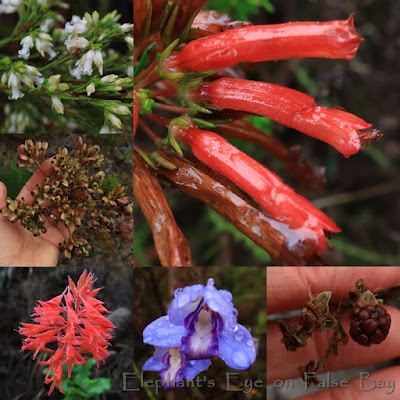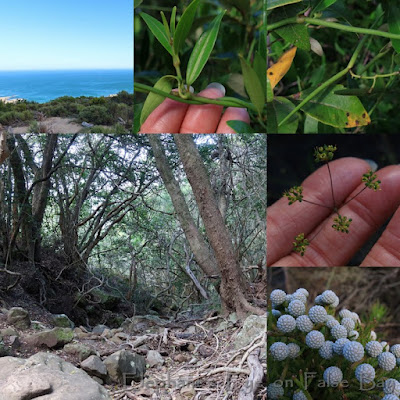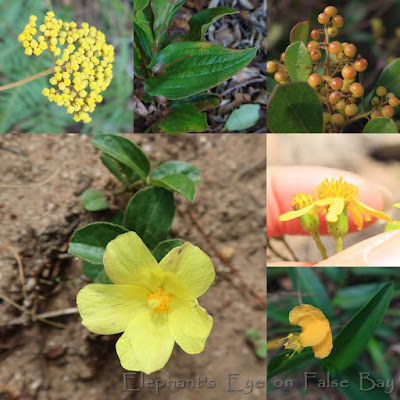March hikes to Elsie's Peak, Silvermine, Myburghskloof and Smitswinkel Bay
by Diana Studer
- gardening for biodiversity
in Cape Town, South Africa
Hiking among wildflowers
in the mountains
around Cape Town
Up Elsie's Peak in March. At teatime I skipped ahead for that view. Makes my heart sing. Wide open view looking across False Bay.
 |
| Looking from Elsie's Peak across False Bay |
Lampranthus bicolor yellow flowers from orange buds. The first Gladiolus brevifolius of the season for us. Lichtensteinia lacera, the 'lacerated' leaves with a carrot and parsley head of flowers. We start just above the houses with this planted or garden escapee Protea hybrid.
 |
| Elsie's Peak March flowers |
Silvermine to Blackburn Ravine for the view. Started with picturesque raindrops on spiderwebs.
 |
| Argiope australis with stabilimentum |
But as we climbed up, for that view, we were walking IN the cloudy Tablecloth. Drip and squelch. Erica lutea double storey flowers. Erica nevillei was new. Nanobubon strictum (carrot and parsley family) Disa red ferruginea and blue graminifolia. Invasive blackberry, Rubus affinis, blame that fruit.
 |
| Erica nevillei in March rain at Silvermine |
Myburghskloof. Bright blue day looking down to Llandudno. New plants Secamone alpini - milkweed from montane (alpine is exaggerated!) forest with two horned fruit, and Cape caraway - Chamarea. Bruniaceae this one is Brunia noduliflora.
Wettest recorded March. But DRY stream - said Peter Johnston geographer at UCT - 'Many streams will flow off Table Mountain during and shortly after the rain, especially if the ground is dry and hard, not much sinks in and it runs off very quickly. In some cases, however, the water is immediately absorbed into the soil where there is vegetation and none runs off. This is probably the case with that stream. During the rainy season, as it rains more, the ground gets softer, more water sinks into the soil and the groundwater then adds to the flow and the streams persist during the dry periods. Then you will find many streams flowing well into summer'
 |
| Secamone alpini at Myburghskloof in March |
Yellow flowers for Myburghskloof. Helichrysum nudifolium, typical flowers but the nudifolium leaf is broad and soft not small with grey velvet. Searsia laevigata berries. Tiny groundcover Hibiscus aethiopicus. Always get bracts for daisies Senecio burchellii. Commelina but yellow for africana.
 |
| Yellow flowers in March at Myburghskloof |
Smitswinkel Bay. 3 of us climbed back up with <3 rocks.
 |
| Smitswinkel Bay I <3 rocks! |
Blue Lobelia boivinii. Each flower with a single petal for Disparago ericoides. Nidorella ivifolia likes damp feet, but leaves not particularly ivyish. Asparagus aethiopicus (again, South of the known world beyond the Sahara desert) with vicious hooked thorns and swathed in white flowers! Neatly toothed leaves for Morella serrata. More berries for coastal subspecies Cassine peragua barbara (that week we had a visiting Barbara too)
 |
| March flowers on Smitswinkel Bay path |
Silvermine to Steenberg Peak for Disa ferruginea. I sweep from the back to catch stragglers. While the others stopped for tea, I forged ahead for extra disas.
 |
| Disa ferruginea in March |
Sign of autumn. Gladiolus brevifolius. Each one playing with white, yellow, pink and purple on the lip markings.
 |
| Gladiolis brevifolius sign of autumn in March |
Turning pink. Serruria fasciflora. Blushing Clutia ericoides. Stoebe fusca (means dark, I wonder why). UPDATE: Male flowers of Restio triticeus. Two peas pale Psoralea laxa and darker Indigofera candolleana.
 |
| Silvermine Steenberg Peak March flowers |
My hikes are listed on my page.
I invite you to join us at Elephant's Eye on False Bay. Please subscribe as you prefer
via Feedly,
or my Facebook blog page
Pictures by Diana Studer
of Elephant's Eye on False Bay
Teal blue text is my links.
To read comments if you are in a Reader,
first click thru to the blog)
Thanks for comments that add value. Your comment will not appear until I've read it. I welcome comments on posts from the last 2 months.
Google and Blogger comments uncooperative? Use Name / URL instead.

Gorgeous scenery, even without the addition of the lovely wildflowers. The photo of Smitswinkel Bay could grace a calendar! Even with our heavy rains and snow levels in the mountains this year, we face the same risk of losing water to rapid runoff before it soaks into soil in the surrounding area, in our case due to higher than desirable spring temperatures causing fast snowmelt.
ReplyDeleteI can see why that scene makes your heart sing...my heart is singing simply from seeing the photo. Loveliness. And all the amazing wildflowers, too. Thanks for sharing the highlights of your hikes!
ReplyDeleteOh it has been too long my friend. I took a blog and social media break but came back recently to see this post. What a breath of fresh air to see your wildflowers and go on a fabulous hike with you once again. I have updated my facebook settings to make sure I see your posts as I had forgotten blogger stopped sending the notifications.
ReplyDelete